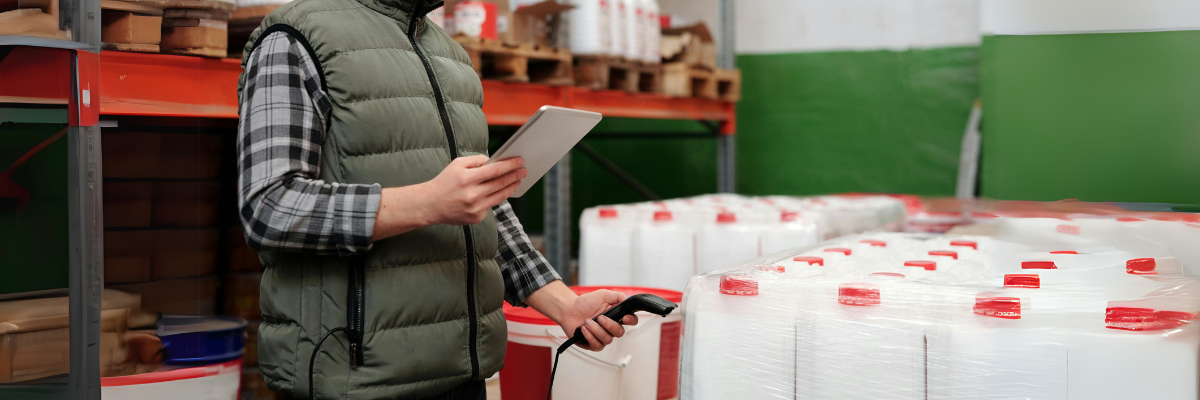Warehouse management is one of the most strategic activities to ensure efficiency, speed, and transparency in the supply chain. In this context, RFID represents one of the most promising technologies to revolutionize inventory, picking, and goods tracking.
To understand how to make the most of this technology, it’s essential to start with the basics: what RFID is, what its fundamental components are, what types of RFID tags exist, and what benefits it offers to companies that choose to implement it in their logistics processes.

RFID meaning: operating principles and components
The term RFID is the acronym for Radio Frequency Identification, meaning radio frequency identification. It is a technology that enables the automatic identification and tracking of objects, animals, or people through radio waves. Unlike barcodes, which require a direct line of sight between the reader and the label, RFID allows reading at a distance without the need for visual contact.
An RFID system is composed of three main elements: the RFID tag, the reader, and the middleware. The RFID tag is a small label equipped with a chip and antenna, applicable to any object or container. The RFID reader, on the other hand, emits a radio signal that activates nearby tags and receives from them the encoded information. The middleware, finally, is the software that connects the readers to the management system, integrating the collected data with the warehouse platform.
Types of RFID tags and selection criteria
There are several types of RFID tags, each with specific characteristics that make it more suitable for certain operational contexts. Tags can be active, passive, or semi-passive. Active tags are powered by an internal battery and have a very long reading range, but also a higher cost. Passive tags, on the other hand, have no built-in power and are activated only when they receive a signal from the reader. Semi-passive tags represent a middle ground, combining some advantages of the two previous models.
Advantages of an RFID system in the warehouse: accuracy and speed
Implementing RFID in the warehouse significantly improves operational efficiency, especially in inventory and picking processes. One of the main advantages is data accuracy: thanks to the automatic and simultaneous reading of multiple tags, it is possible to achieve real-time visibility of stock levels, reducing human errors and inventory discrepancies.
Operational speed also benefits significantly. The operator no longer needs to manually scan each individual item: the RFID system reads all the tags present in an area, speeding up both inbound and outbound goods checks.
Integration with inventory management, picking, and tracking
The integration of RFID with the existing management system represents the true strength of the technology. Intelligent tracking solutions allow you to follow each item along the entire logistics chain, from receipt to picking, all the way to shipment. The information collected by RFID readers can be automatically synchronized with the inventory management software, keeping stock levels, locations, and movements updated in real time.
During the picking phases, RFID readers can be positioned along the picking routes or integrated into the mobile devices used by operators. This way, it is possible to verify in real time that the selected items are correct, reducing error rates and improving order accuracy.
Costs, ROI and use cases
The cost of an RFID system varies depending on the complexity of the infrastructure, the number and type of tags used, and the level of software integration required. Many companies in the retail, food, and logistics sectors are already adopting RFID in the warehouse to eliminate waste, optimize space, and reduce costs related to picking errors and failed deliveries. In other cases, the introduction of RFID has led to increased inventory accuracy, significantly reduced audit times, and greater reliability in delivery promises.

Operational steps to implement RFID with technological solutions
The implementation of an RFID system requires careful planning. The first step involves a thorough analysis of existing logistical flows and the critical issues to be resolved. Subsequently, you need to choose the most suitable technology: tags, readers, software, and infrastructure must all align with operational requirements.
It is essential to rely on reliable technological solutions, capable of ensuring scalability and interoperability with existing tools. Expert partners in the industry such as Hubrise can provide support both during the design phase and in testing and validation, ensuring a smooth implementation with no disruption to daily operations.
Roadmap for an RFID-ready warehouse
The adoption of an RFID system in the warehouse is not just a technological choice, but a true paradigm shift in logistics management. To achieve concrete results, it is essential to understand the meaning of RFID, know the different types of RFID tags available, assess their impact on processes, and carefully plan every phase of the project.
An RFID-ready warehouse is a connected environment where every item is tracked in real time and every movement is recorded automatically. This leads to a drastic reduction in errors, increased productivity, and an improved experience for the end customer. With the right technological solutions and a well-structured roadmap, even medium-sized companies can now access the benefits of RFID, optimizing the entire supply chain and successfully positioning themselves in an increasingly competitive market. If you want to know how to implement RFID code within your warehouse, contact Hubrise!